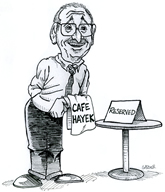Here’s a letter to Real Clear Policy. (For alerting me to this piece by Jahncke, I thank George Leef.)
Editor:
Attempting to find revolutionary genius in Trump’s 17th-century mercantilist policies, Red Jahncke repeats familiar fallacies, such as that today’s capital mobility results in low-wage China draining investments away from high-wage United States (“Trump’s Tariffs: Rewriting Economic Thinking About Free Trade,” August 2). In reality, in 2024 net inward foreign direct investment in the U.S. was $388.0 billion while in China it was $18.6 billion, or a mere 4.8 percent of what was invested in the U.S. (On a per-capita basis, net FDI in China was a measly 1.1 percent of that of the U.S.) Indeed, last year almost one in every three dollars of global net foreign direct investment was done in the U.S.)
It’s no surprise, then, that U.S. industrial capacity is today at an all-time high.
Another fallacy served up by Mr. Jahncke is the notion that (in his words) “comparative advantage assumes some minimal level of parity between trading partners.” Using David Ricardo’s famous example of England trading cloth to Portugal in exchange for wine, he writes:
Comparative advantage assumes some minimal level of parity between trading partners, that both have effective production capability – cloth and wine in England and Portugal in David Ricardo’s famous example. Portugal had an absolute advantage in both – but only 10% in cloth versus 50% in wine. So, both countries benefited if Portugal ceded cloth to England and produced only wine.
However, what if Portugal had a 75% advantage in both? Portugal’s huge absolute advantage would have put England out of business.
Mr. Jahncke doesn’t understand comparative advantage.
First of all, in the second quoted paragraph he simply assumes comparative advantage away. By writing that Portugal has “a 75% advantage in both,” he assumes away the one condition that is required for comparative advantage to exist, namely, that one country’s efficiency at producing (say) cloth relative to (say) wine differs from the other country’s efficiency at producing cloth relative to wine. (This move by Mr. Jahncke springs, no doubt, from his ignorance of economics rather than from any intention to hoodwink your readers.)
Second, contrary to the thrust of Mr. Jahncke’s point, the existence of comparative advantage doesn’t in the least depend upon two economies being relatively similar to each other in overall productivity. It’s true that Americans and Canadians both gain by trading with each other according to comparative advantage, but it’s equally true that Americans and the Chinese both gain by trading with each other according to comparative advantage
The irony of Mr. Jahncke’s mistaken argument is that, if it were correct, no tariffs would be necessary to prevent Americans from trading with the Chinese because, to paraphrase Mr. Jahncke, “America’s huge absolute advantage would have put China out of business” (as a trader with the U.S., although not literally). After all, American workers are vastly more productive than are Chinese workers: In 2019, American workers on average produced 6.3 times more output per hour than did Chinese workers.
It’s easy to make a case for protectionism by ignoring economic theory and economic facts. But once these realities are taken into account, the case for protectionism crumbles.
Sincerely,
Donald J. Boudreaux
Professor of Economics
and
Martha and Nelson Getchell Chair for the Study of Free Market Capitalism at the Mercatus Center
George Mason University
Fairfax, VA 22030



